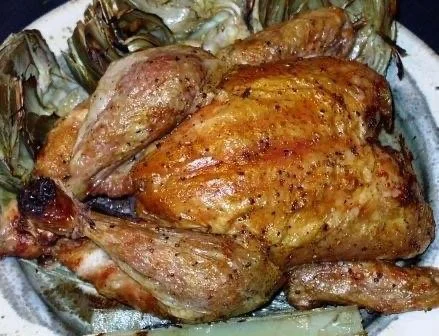Skip the Rotisserie Chicken
Just about every major newspaper food section, blog, and September magazine has a story about rotisserie chicken now that summer vacations are over and school is back in session. They’re referred to as “shortcuts” and “time-savers”, but let’s tell the truth about a bird that costs less than buying a fresh one and cooking it yourself. Americans buy approximately a billion rotisserie chickens each year mostly from grocery stores and bulk discount stores.
Why are rotisserie chickens so cheap?
As the old adage goes, you get what you pay for. Pre-cooked rotisserie chickens cost anywhere between $5 and $12. Typically, they’re smaller birds, 2 to 2.5 pounds, meaning you’re getting less than what a typical broiler or roast would weigh. Even the National Chicken Council agrees that despite their reputation for being inexpensive, rotisserie chickens generally cost more per pound because they’re significantly smaller.
And I guarantee that they won’t be birds that have lived their life on pasture and are fed the best possible feed by the farmers who own the birds. Rotisserie chickens are possible thanks to industrial agriculture. That Costco bird cost $0.35-0.50 to raise. The average cost of a chicken out of a concentrated animal feeding operation where the birds and feed are supplied to a contract grower who takes on all the risk and responsibility nets the farmer less than $0.30 per bird. An average contract barn holds 20,000 birds.
Do you like Maryland Blue Crabs from the Chesapeake Bay or wild-caught Gulf Coast shrimp? If so, pass on the rotisserie bird as commercial poultry operations have been pegged for much of the agricultural pollution causing the collapse of commercial fisheries due to elevated nitrates from excessive nutrient runoff.
Are rotisserie chickens a healthy meal?
The rise of the rotisserie chicken came at a time when red meat was being blamed for mounting health problems. Chicken became the healthy alternative. But today elevated sodium content and preservatives are also being blamed for rising health issues such as high blood pressure and heart disease. Rotisserie chickens are injected with water, salt, and starch or gum like carrageenan. Added water keeps the meat moist on the warming table; salt enhances flavor and helps retain water; and the additives help maintain flavor and keep the chicken moist. The average amount of injected additives can account for as much as 20% of the rotisserie chicken’s weight. That’s not protein you’re paying for. Due to all the additives, rotisserie chicken are considered processed food.
But I don’t have time to cook.
Or I don’t know how or it’s just me…excuses, excuses. Roasting a whole chicken, which is akin to a rotisserie bird, is as simple as sprinkling herbs and spices on a fresh bird and baking it in an oven for an hour. Pull on a wing or leg to see it it’s done. If the appendage breaks free, it’s cooked. Cook your bird while you’re in the shower, working out, watching TV, or while the kids are doing homework. Pick off your favorite parts for an immediate meal and then pull the rest of the meat off the bones for salads, tacos, stir-fry, or to toss with pasta. And don’t forget the carcass. The bones from a roasted chicken make great bone broth. Cover the bones with water and simmer to make your own.
If you’re reading this blog chances are you’re also shopping at the farmers markets. Raising good poultry takes a lot of work. Like all agrarian endeavors, it’s dependent on the whims of the weather and the biological proclivities of life in general. We all saw the impact a national outbreak of avian influenza and a freak snowstorm that shut down I95 had on the meat birds, turkeys, and eggs last year. Or how about when COVID closed many of the large-scale commercial processors.
I can’t shout it loud enough—shortening your supply chain by buying direct from a farmer is food security, it’s reducing your food’s carbon footprint, it’s helping to conserve farmland, open space, and wildlife. Farmers selling direct to consumers know who and how their stock are processed since they are using regional processing facilities who, in turn, create jobs and business to business commerce. Supporting local farmers keeps the money in your community and reduces inequitable labor practices. Sure, that chicken at the market may cost more than a rotisserie bird and you’re going to have to cook it yourself, but it’s a worthwhile investment in the long run.

